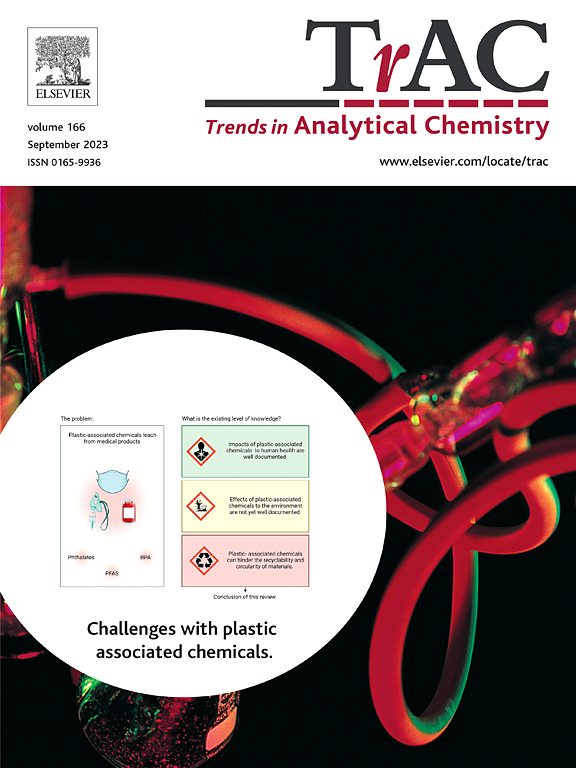Reviewing the fundamentals and best practices to characterize microplastics using state–of–the-art quantum-cascade laser reflectance-absorbance spectroscopy
IF 11.8
1区 化学
Q1 CHEMISTRY, ANALYTICAL
引用次数: 0
Abstract
Microplastic pollution studies depend on reliable identification of the suspicious particles. Out of the various analytical techniques available to characterize them, infrared transflectance using a tuneable mid-IR quantum cascade laser is a high-throughput state-of-the-art imaging option, specifically Agilent's QCL-LDIR (Quantum Cascade Laser Direct Infrared imaging). Its conceptual grounds are reviewed, instrumental developments are discussed, along with a review of applications and best practices to overcome obstacles/difficulties in routine measurements, namely: the spectral range, the variation of some peak intensities with the particles size, processing speed, and avoiding the use of measurement aliquots. Objective procedures to avoid too many false positives when identifying spectra and to distinguish fibers and fragments are given. These practices open a path to QCL-LDIR measurement standardization and potential use for microplastics monitoring, as requested by many governmental bodies in charge of setting environmental protection rules.

回顾使用最先进的量子级联激光反射-吸收光谱表征微塑料的基本原理和最佳实践
微塑料污染研究依赖于对可疑颗粒的可靠识别。在可用于表征它们的各种分析技术中,使用可调谐中红外量子级联激光器的红外透射是一种高通量的最先进成像选择,特别是安捷伦的QCL-LDIR(量子级联激光直接红外成像)。回顾了其概念基础,讨论了仪器的发展,以及克服常规测量中障碍/困难的应用和最佳实践的回顾,即:光谱范围,一些峰强度随粒径的变化,处理速度,以及避免使用测量等分。客观程序,以避免太多的假阳性时,识别光谱和区分纤维和碎片。这些做法为QCL-LDIR测量标准化和微塑料监测的潜在用途开辟了道路,这是许多负责制定环境保护规则的政府机构所要求的。
本文章由计算机程序翻译,如有差异,请以英文原文为准。
求助全文
约1分钟内获得全文
求助全文
来源期刊

Trends in Analytical Chemistry
化学-分析化学
CiteScore
20.00
自引率
4.60%
发文量
257
审稿时长
3.4 months
期刊介绍:
TrAC publishes succinct and critical overviews of recent advancements in analytical chemistry, designed to assist analytical chemists and other users of analytical techniques. These reviews offer excellent, up-to-date, and timely coverage of various topics within analytical chemistry. Encompassing areas such as analytical instrumentation, biomedical analysis, biomolecular analysis, biosensors, chemical analysis, chemometrics, clinical chemistry, drug discovery, environmental analysis and monitoring, food analysis, forensic science, laboratory automation, materials science, metabolomics, pesticide-residue analysis, pharmaceutical analysis, proteomics, surface science, and water analysis and monitoring, these critical reviews provide comprehensive insights for practitioners in the field.
 求助内容:
求助内容: 应助结果提醒方式:
应助结果提醒方式:


